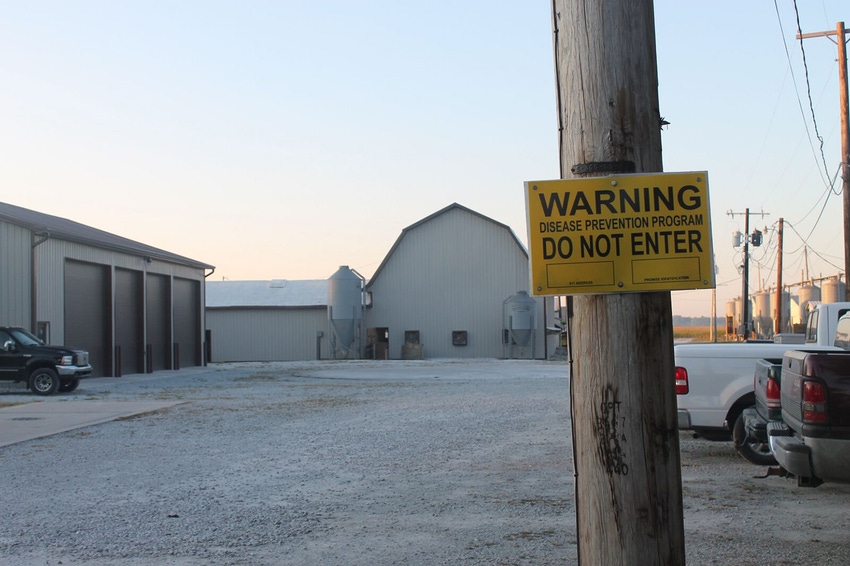Through their risk assessments, the ISU team has found several key areas pork producers can work on to improve biosecurity on their farms.

Ever since I attended the Carthage Veterinary Service Swine Conference a couple weeks ago, I’ve had the term “locomotion” rolling around in my head. No, the Carthage team wasn’t playing the song made popular by the likes of Little Eva, Grand Funk Railroad and Kylie Minogue. It was a word Gustavo Silva used during his presentation on “Risk Assessments and Biosecurity Focus.”
Pathogens are not capable of locomotion and must be carried by something else. Whether it’s employees, transportation, feed, water, equipment, replacement animals, wildlife or the air, those pesky microorganisms have to hitch a ride to come into your farm. To stop this locomotion, the Iowa State University fellow who is currently partnering with Carthage Innovative Swine Solutions team, says the industry should consider layering in its biosecurity practices.
“Remember that for pathogens to infect an animal, we need three steps,” Silva says. “First, the pathogen needs to be alive and in the carrying agent. Then the carrying agent needs to have contact with susceptible animals, and the last one, the number of pathogens that are in that thing have to be in high enough numbers to overcome the immunity of the animal and to provoke the disease.”
By incorporating multiple biosecurity practices or placing “layers” in the process, pork production systems can put up physical barriers and decrease pathogen load, all while leaving room for error.
For example, Silva says two simple opportunities for including biosecurity layering is the processes for entering a farm and gilt delivery.
When entering a farm, all individuals can put on booties over their shoes before leaving a vehicle, then use a disinfection mat at the entrance and remove outside shoes using a bench system. From there individuals can remove their outside clothes, shower and put on farm clothes and boots.
Before gilts are delivered, they can be checked for disease status at the multiplier. The truck can be washed, disinfected and baked before gilts are loaded and the truck can follow a clean/dirty line in transportation on loading gilts at farms. Gilts can be held in an isolation unit to test before entering the herd. Farms could also consider reducing the frequency of gilt delivery to reduce the risks.
“This same process can be used for all the other things that happen on the farm daily, but usually we do a lot of steps on the farm and we didn’t set up a time to understand what’s going on and what we should do, and if the things that we are doing is the correct way to do so,” Silva says.
That’s why the ISU team has developed a porcine reproductive and respiratory syndrome biosecurity risk assessment to help producers find all the potential ways these pathogens can be introduced on a farm. The process involves first quantifying the overall risks on farm and then generating a risk score from 0 (low risk) to 1 (high risk).
“Besides the location and herd size, we will also look at the swine movement that occurs on the farm daily. We also look for big deliveries. We look for all people movement from farm employees to visitors,” Silva says. “We look at the entry of food and product that the employees will consume on the farm, the manure removal and entry of other kinds of animals — insects, rats, those kinds of things — and if the farm is filtered and water source. We assess the whole herd to try to understand and find biosecurity gaps to move forward.”
Thus far, the ISU team has investigated more than 100 herds from 22 different production systems, ranging from 300 to more than 11,000 animals per sow farm. On average these herds usually have one PRRS outbreak every 2.5 years and the average biosecurity risk score is 0.33 or 33%.
“When we look at the benchmark of all the herds so far, we can see a trend,” Silva says. “The higher they score, the higher the frequency of PRRS outbreaks in the past five years and we can compare these farms against the other ones and see what they are doing different from them to better manage disease transmission.”
Through their risk assessments, the ISU team has found several key areas producers could work on to improve biosecurity on their farms. Silva says almost half of the sow farms they assessed need to better understand swine movements, such as semen delivery, gilt delivery, cull removal and weaning events. The next area of improvement involves water source and air filtration as 38% of the farms demonstrated a need to get a better grasp of site locations and the pig density and the filtration in their areas.
For example, the ISU risk assessment exercises found a higher risk for PRRS happening on those sites that:
Shared the same breeding replacement trailer
Hauled culled sows more often per month
Had more renderings per month
Were located within three miles from a number of other swine sites
Experienced a higher employee turnover on an annual basis
“Biosecurity is a daily obligation and training is key to increasing that compliance because it’s a war that we do every day. Every day we have to do the same thing and we have to do it properly,” Silva says. “Also, one thing that we have to keep in mind is we can’t eliminate the risk of disease introduction, but we can find the things that we are doing wrong and try to measure them to do better going forward and also by reducing the frequency. If we can reduce the opportunity, we are more likely to have success and decrease the risk of PRRS introduction.”
About the Author(s)
You May Also Like





